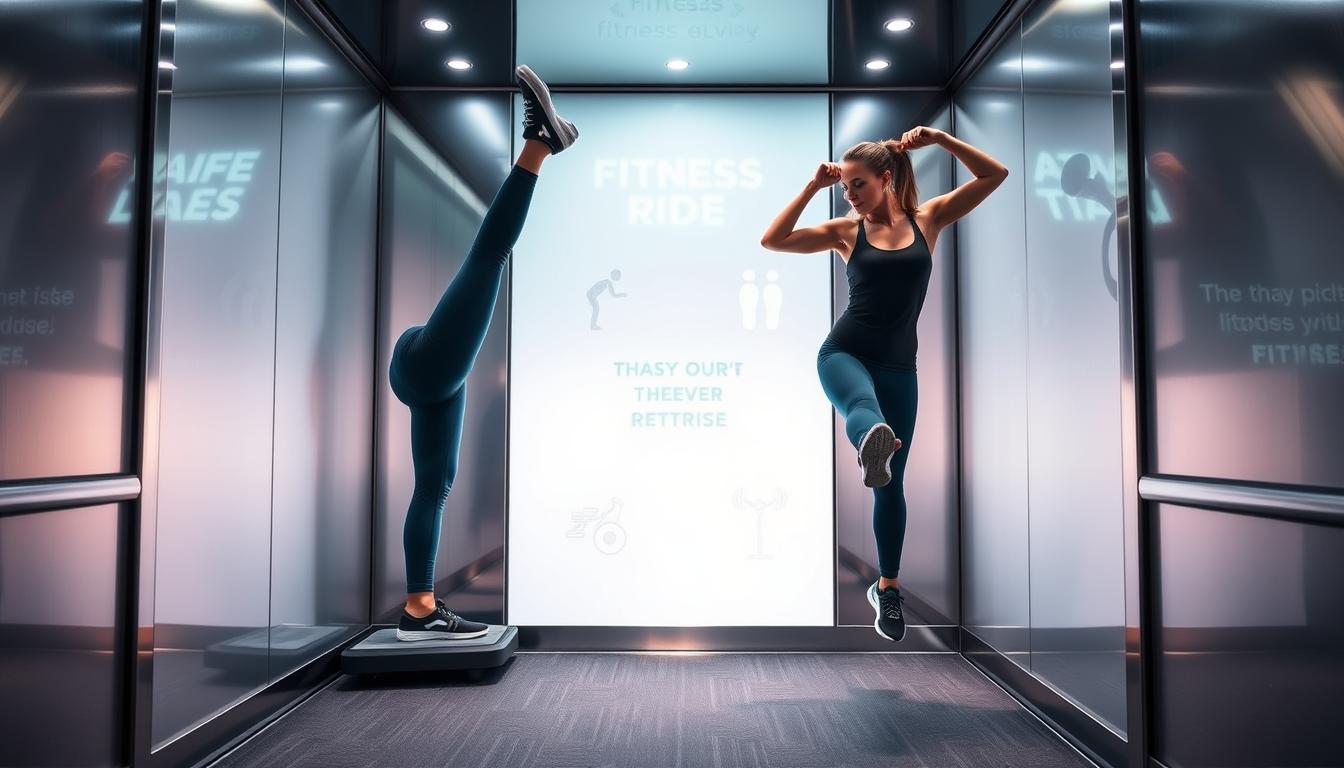High-intensity interval training, or HIIT, is a game-changer for busy folks. It lets you get big fitness results in short workout sessions. It’s perfect for those tight on time but craving intense workouts. This method helps you work out smarter, not longer, making your lifestyle healthier without eating up your schedule. With HIIT, you can boost your workout game and enjoy the perks of quick yet effective exercises. This leaves you with more time for daily tasks.
Understanding High-Intensity Interval Training
High-Intensity Interval Training (HIIT) mixes hard work periods with easier recovery times. This method comes from old survival skills, teaching us to use energy in bursts, then rest. It helps people get fit by offering workouts that match their personal needs.
- High-intensity interval training (HIIT)
- Tabata, which consists of 20 seconds of maximum effort followed by 10 seconds of rest
- Norwegian 4×4 interval training, featuring 4 minutes of intense work followed by 3 minutes of recovery, repeated four times
Doing interval training often brings many health perks.
- It makes your heart work better and improves blood flow
- Keeps blood vessels healthy
- Helps you burn fat faster and boosts metabolism
A bit of research shows that short sprints of 30 seconds can be as good as 90-120 minutes of normal exercise. Just 15 minutes of hard activities each week could cut the risk of dying early by 16-18%. This tells us that working harder for shorter times is more effective than long, slow workouts.
To make workouts better, it’s smart to lift weights carefully and increase them slowly. This way, you stay safe and keep your workouts strong. Don’t do risky moves. Holding a pose or doing slow lifts can also make your muscles work harder in a short time.
The Science Behind Interval Training
HIIT, or High-Intensity Interval Training, mixes short, powerful exercise bursts with rest times. This method improves heart efficiency and boosts fat loss. When we do HIIT, our hearts get stronger, blood flows better, and we stay healthier overall. This helps keep us fit and lowers our risk for serious illnesses.
HIIT also has an “afterburn effect,” meaning our bodies burn calories even after we stop exercising. This helps us use fat for energy, making it great for weight control. Research says HIIT helps people lose more belly and body fat than regular workouts.
Short high-intensity exercises can greatly improve our health. Even 15 minutes of HIIT weekly can cut heart disease and cancer risks. Plus, HIIT boosts our metabolism, helps us burn more calories, and enhances how our body uses sugar.
What’s great about HIIT is it saves time, perfect for those with busy schedules. It doesn’t just help with fat loss; it also keeps our muscles strong. This makes HIIT a smart way for anyone to stay in shape.
Benefits of High-Intensity Interval Training at Elevator
High-Intensity Interval Training (HIIT) at Elevator is popular for its dynamic benefits. It allows you to burn 25–30% more calories than usual workouts. This means rapid fat loss and overall health improvement.
HIIT boosts heart health. It improves oxygen use and lowers heart rate and blood pressure. It’s great for those with overweight, offering effective workouts. It also reduces body fat and waist size, helping in fat loss.
HIIT increases your metabolic rate even after the workout. This “afterburn effect” helps burn more calories. Even 15-minute sessions offer major benefits, fitting easily into tight schedules.
HIIT is flexible, working for all fitness levels. Activities can range from stair sprints to structured elevator exercises. No special gear is needed. It boosts both aerobic and anaerobic fitness, making it great for everyone.
Small changes, like choosing stairs over an elevator, lead to big health benefits. HIIT offers flexible, effective workout options. It’s a solid choice for reaching fitness goals.
Getting Started: Preparing for Your HIIT Workout
Getting ready for a High-Intensity Interval Training workout involves some key steps. You need to prepare properly to do your best and avoid getting hurt. Start with a 5-10 minute dynamic warm-up including jumping jacks, high knees, and plank hip extensions. This gets your heart going and makes you more flexible, helping you have a great workout.
If you’re just starting, it’s important to use a 1:2 work-to-rest ratio. That means you do 30 seconds of hard work followed by 60 seconds of rest. This approach keeps you ready for more and ensures you don’t push too hard too soon.
Begin with bodyweight exercises like squats, jumping lunges, and push-ups. These basic moves are great for gaining strength and prepping for harder training. Plan for three rounds of these exercises, taking 15 seconds of rest between them, and up to a minute rest between rounds.
Keeping hydrated and following a regular workout schedule helps a lot in the long run. By doing these things as part of your HIIT prep, you’re setting yourself up to benefit more. You’ll boost your metabolism and heart health this way.
Choosing the Right Exercises for Your HIIT Routine
Choosing the right HIIT exercises is key for the best outcomes. A smart mix of bodyweight and weighted exercises works many muscle groups. Start with simple exercises like burpees to hit your glutes, core, and shoulders. As you get fitter, add weighted exercises like kettlebell swings to strengthen your glutes, hamstrings, and core.
Adding walking weighted lunges works your quads, calves, and core, boosting your functionality and endurance. Dumbbell renegade rows target your back and core, also aiding in balance and stability. Goblet squats boost your lower body and core. Weighted sled pushes offer benefits for a total body workout.
Using a variety of these effective exercises makes your sessions exciting and keeps you motivated. Beginners should ensure they’re doing exercises correctly to prevent injuries and slowly up the intensity. A circuit format with proper rest times helps with recovery. To keep things interesting, throw in cardio moves like mountain climbers and high knees, blending cardio with strength training.
Sticking to a weekly schedule helps you stay on track, leading to muscle building and improvement. Beginners should start with a work-to-rest ratio of 30:15. This helps your body handle the high-energy workouts well. Using the rating of perceived exertion (RPE) lets you monitor how hard you’re working, aiming for a 4 to 6 on a 0 to 10 scale.
High-Intensity Interval Training at Elevator: Effective Strategies
Elevator workouts are a great way to do HIIT in a small space. Using stairs boosts your heart health and makes good use of the area. By mixing intense exercises with rest periods, workouts become fun and effective.
Utilizing Stairs: A Natural HIIT Environment
Stairs are perfect for HIIT. Start with a 3-5 minute warm-up to get your muscles ready. Then, use stair climbing for high-intensity bursts, with slower exercises for recovery. This approach keeps your workout challenging but manageable.
By focusing on stairs, your sessions become more efficient. They enhance both your strength and stamina.
Bodyweight Exercises for Maximum Efficiency
Include bodyweight exercises in your HIIT routine. Push-ups, squats, and jumping jacks are good options that need no equipment. They fit any fitness level, making workouts accessible to all.
Adapt exercises for small spaces and emphasize form to avoid injuries. Starting with dynamic stretches can improve flexibility and reduce the chance of getting hurt. This helps you get the most out of each workout.

Structuring Your HIIT Workouts
Planning your HIIT workouts well is key to doing well and staying safe. It’s important to set the right work-rest times. This matters whether you’re just starting out or you’re an expert. Changing these times can make your workouts better and your results stronger.
Work-to-Rest Ratios to Optimize Performance
Beginners should start with a work-to-rest ratio of 1:2. This means doing 30 seconds of intense work followed by 60 seconds of rest. As you get fitter, you might move to a 1:1 ratio, balancing exercise and rest equally. Advanced folks often aim for a 2:1 ratio for more intensity. Studies show that 1:1 or 2:1 ratios are great for improving heart health,
which is why they’re often used in good training plans.
Sample HIIT Workout Routines
Trying different HIIT workouts can make things more interesting and challenging. Here are examples for various fitness levels:
- Tabata HIIT: This includes 8 rounds of 20 seconds hard work and 10 seconds rest. This adds up to 4 minutes.
- Cardio HIIT: Do high-intensity exercises for 20 seconds, rest for 10 seconds, and repeat 3 times. It gives a quick cardio boost.
- Full Body HIIT: Spend 60 seconds on exercises that target all major muscles, then rest for 30 seconds. Do this 4 times.
- Weight-based HIIT: Perform 40 seconds of weighted exercises, rest for 30 seconds, and repeat 3 to 4 times. It’s great for gaining strength.
How long your session should be varies: beginners should aim for 15-20 minutes, those in the middle 18-25 minutes, and experts 10-25 minutes. Using short work intervals, from 30 to 60 seconds, helps keep up the intensity.
Common Mistakes to Avoid During HIIT
High-Intensity Interval Training works wonders if done right. Knowing common HIIT slip-ups improves safety and results. People often misuse HIIT for building muscle. It’s better to lift heavy weights for muscle growth. Also, HIIT shouldn’t exceed 30 minutes to stay effective. Rest is crucial, so limit HIIT to four times weekly.
When you train matters too. Working out early can increase fat loss. Warming up with low-intensity moves prepares your body well. Keep equipment simple; bodyweight or light weights often do the trick.
Avoid skipping warm-ups or cooldowns to dodge injuries. Eating before exercising boosts your performance. Keep intervals short, under 30 seconds, for the best intensity. Be careful with your exercise forms to avoid harm. Don’t rest too long between sets, and ensure you’re working hard enough. Wrong shoes or tight clothes will impact your workout negatively.
Too much HIIT can cause burnout and injuries. Enjoying your workouts helps keep you going. Learn proper techniques before ramping up the intensity for safer workouts. Use modifications to build strength without risking injury from heavy weights. Aim to keep your heart rate at 80-90% of its max for best results.
Add flexibility exercises like yoga to improve mobility and reduce injury risks. Don’t skip eating before workouts; a mix of protein and carbs is ideal for strength sessions. A positive attitude enhances the benefits and enjoyment of your workouts.
Recovery and Nutrition for HIIT Athletes
For athletes doing high-intensity interval training (HIIT), recovery is key. It’s about both physical rest and eating right. Walking or slow cycling for 3-5 minutes right after HIIT helps the body switch from high energy to a more relaxed state. This also gets blood flowing to tired muscles.
Adding dynamic stretching or massage therapy can stop muscle knots. It also makes you more flexible. Athlete nutrition is super important for recovery. Eating foods full of antioxidants like berries and greens helps fight off cell damage. After working out, it’s crucial to eat carbs and protein. This mix helps fix and grow muscles.
Keeping enough glycogen for energy is essential for HIIT. Eating a meal full of carbs and protein 3 to 4 hours before works great. Also, a carb snack an hour before exercising helps a lot. Your post-workout meal should have more carbs than protein to refill energy and fix muscles.
Rest is super important; it makes recovery from HIIT better. Limiting intense workouts to twice a week is a good idea. Using recovery methods like professional massage and stretching really helps. For athletes wanting better performance, it’s vital to look after your overall health. This means eating well, sleeping enough, and managing stress.
Tracking Progress and Staying Motivated
Keeping up with a workout consistency in HIIT means tracking your progress well. Use something like a wall calendar to mark off the days you hit your goals. Seeing your achievements every day boosts your HIIT motivation greatly.
Focus on doing something each day rather than being perfect. A less-than-perfect workout still pushes you forward. By following the “Never Miss Twice” rule, you’ll stay on track even if you slip up once, helping you reach your fitness goals.
Make your goals clear, like planning a 10-minute walk daily. Using a progress tracker, either an app or a notebook, keeps you aware and motivated. This helps you stay on top of your workout consistency.
Try for achievable goals, for example, walk 7,500 steps five days a week. Scheduling set times for your workouts promotes accountability and keeps you consistent.
Having friends to keep you in check, or even a personal trainer, can really fuel your HIIT motivation. Not to forget, working out lessens stress and boosts your confidence, making it easier to stick with your fitness goals.
Conclusion
High-intensity interval training (HIIT) at Elevator is great for improving fitness fast. It doesn’t take much time. By choosing the right HIIT workouts, you can get better heart health and more stamina. Elevator’s program is designed well and works for all ages.
Stats show HIIT’s success, with an 88% completion rate in some studies. This means people like it and stick with it. Exercises like burpees and squat jumps make you stronger and fitter, showing great results.
So, adding HIIT to your routine is a smart move. It can really boost your health. Elevator’s HIIT is a top choice for boosting your fitness game. Don’t forget to rest and recover to keep up your performance and enjoy HIIT’s full benefits.



